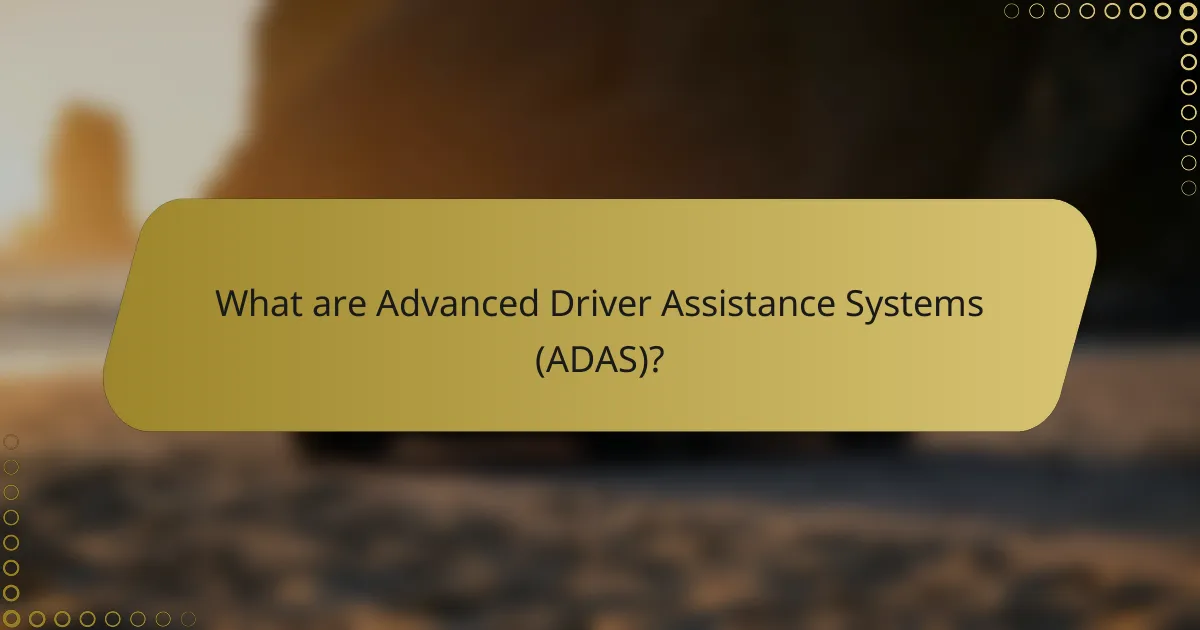Advanced Driver Assistance Systems (ADAS) are technologies designed to enhance vehicle safety and driving convenience through features such as lane-keeping assistance, adaptive cruise control, and automatic emergency braking. These systems utilize sensors and algorithms to provide real-time data, significantly reducing the likelihood of accidents. Research indicates that vehicles equipped with ADAS experience a 50% reduction in crash rates, contributing to lower insurance premiums and promoting safer driving habits. Understanding the functionalities of ADAS, including regular software updates and proper usage, is essential for maximizing their benefits and ensuring a secure driving experience.

What are Advanced Driver Assistance Systems (ADAS)?
Advanced Driver Assistance Systems (ADAS) are technologies designed to enhance vehicle safety and facilitate driving. These systems utilize sensors, cameras, and algorithms to provide real-time data to drivers. Common features include lane-keeping assistance, adaptive cruise control, and automatic emergency braking. According to the National Highway Traffic Safety Administration, ADAS can significantly reduce the likelihood of accidents. Studies show that vehicles equipped with ADAS have lower crash rates compared to those without. This demonstrates the effectiveness of ADAS in improving road safety.
How do Advanced Driver Assistance Systems function?
Advanced Driver Assistance Systems (ADAS) function by utilizing various sensors and technologies to enhance vehicle safety and assist drivers. These systems employ cameras, radar, and lidar to gather data about the vehicle’s surroundings. The information collected is processed in real-time to detect obstacles, lane markings, and traffic signs. ADAS can provide alerts to the driver or even take control of the vehicle in certain situations. For example, features like adaptive cruise control adjust the vehicle’s speed based on traffic conditions. Other functions include automatic emergency braking and parking assistance. According to the National Highway Traffic Safety Administration, ADAS can significantly reduce the likelihood of accidents by improving situational awareness.
What technologies are utilized in Advanced Driver Assistance Systems?
Advanced Driver Assistance Systems (ADAS) utilize various technologies to enhance vehicle safety and driving efficiency. Key technologies include radar, which detects distance and speed of nearby objects. Cameras provide visual data for lane-keeping and obstacle recognition. Lidar uses laser light to create detailed 3D maps of the environment. Ultrasonic sensors assist with parking and low-speed maneuvers. GPS technology enables precise vehicle positioning and navigation. Each of these technologies contributes to features such as adaptive cruise control, automatic emergency braking, and lane departure warnings. The integration of these technologies significantly reduces the risk of accidents and improves overall driving experience.
How do sensors and cameras contribute to ADAS performance?
Sensors and cameras are critical components of Advanced Driver Assistance Systems (ADAS). They enhance vehicle safety and performance by providing real-time data about the vehicle’s surroundings. Cameras capture visual information, enabling features like lane departure warnings and traffic sign recognition. Sensors, such as radar and lidar, detect objects and measure distances, facilitating adaptive cruise control and collision avoidance. Together, these technologies improve situational awareness, allowing vehicles to respond effectively to dynamic driving conditions. Studies show that vehicles equipped with ADAS can reduce accident rates by up to 40%. This demonstrates the significant impact of sensors and cameras on overall road safety and driving efficiency.
What are the key features of Advanced Driver Assistance Systems?
Advanced Driver Assistance Systems (ADAS) include features that enhance vehicle safety and improve driving experience. Key features are adaptive cruise control, lane departure warning, and automatic emergency braking. Adaptive cruise control maintains a set speed while adjusting for traffic conditions. Lane departure warning alerts drivers when they unintentionally drift from their lane. Automatic emergency braking activates when a collision is imminent, applying brakes to prevent or mitigate impact. Additional features include blind-spot monitoring and parking assistance. Blind-spot monitoring detects vehicles in adjacent lanes, enhancing awareness. Parking assistance aids in maneuvering the vehicle into tight spaces. These features collectively contribute to reducing accidents and improving driver confidence.
What types of assistance do these systems provide to drivers?
Advanced Driver Assistance Systems (ADAS) provide various types of assistance to drivers. These systems enhance safety and improve driving comfort. Common assistance types include adaptive cruise control, which maintains a set speed while adjusting to traffic conditions. Lane departure warning alerts drivers when they unintentionally drift from their lane. Automatic emergency braking can detect potential collisions and apply brakes to prevent or mitigate accidents. Parking assistance helps drivers maneuver into parking spots by providing guidance or automatically steering the vehicle. Blind-spot detection monitors areas that are not visible to the driver and warns them of vehicles in those zones. These features collectively contribute to safer driving experiences and reduce the likelihood of accidents.
How do ADAS enhance vehicle safety?
ADAS enhance vehicle safety by providing automated features that assist drivers in avoiding accidents. These systems include adaptive cruise control, lane departure warnings, and automatic emergency braking. They use sensors and cameras to monitor the vehicle’s surroundings. This technology helps detect potential hazards in real-time. Studies show that vehicles equipped with ADAS can reduce crash rates by up to 40%. The National Highway Traffic Safety Administration supports this statistic, highlighting the effectiveness of these systems in preventing collisions. By alerting drivers and taking corrective actions, ADAS significantly improve overall road safety.

What are the benefits of Advanced Driver Assistance Systems?
Advanced Driver Assistance Systems (ADAS) enhance vehicle safety and improve driving convenience. They reduce the risk of accidents through features like automatic emergency braking and lane-keeping assistance. ADAS can also assist with parking and provide adaptive cruise control. These systems often lead to lower insurance premiums due to decreased accident rates. According to the Insurance Institute for Highway Safety, vehicles with ADAS experience a 50% reduction in crash rates. Additionally, ADAS technology can help drivers avoid distractions, promoting safer driving habits. Overall, ADAS contributes to a more secure driving experience and increased road safety for all users.
How do Advanced Driver Assistance Systems improve road safety?
Advanced Driver Assistance Systems (ADAS) improve road safety by providing real-time support to drivers. These systems utilize sensors and cameras to monitor the vehicle’s surroundings. They can detect potential hazards and alert the driver to take action. Common features include lane departure warnings, adaptive cruise control, and automatic emergency braking. Studies show that vehicles equipped with ADAS can reduce accidents by up to 40%. For example, a report by the National Highway Traffic Safety Administration found that forward collision warning systems reduce rear-end crashes by 27%. Overall, ADAS enhances driver awareness and response, significantly contributing to safer road conditions.
What statistics support the safety benefits of ADAS?
Advanced Driver Assistance Systems (ADAS) significantly enhance vehicle safety. Studies show that ADAS can reduce crash rates by up to 40%. For instance, the Insurance Institute for Highway Safety (IIHS) reports that vehicles equipped with automatic emergency braking have a 50% lower rate of rear-end collisions. Additionally, lane-keeping assist systems can decrease lane departure crashes by 11%. The National Highway Traffic Safety Administration (NHTSA) states that ADAS features can prevent approximately 1.3 million crashes annually. These statistics illustrate the effectiveness of ADAS in improving road safety.
How do ADAS reduce accident severity?
ADAS reduce accident severity by providing real-time assistance to drivers. These systems utilize sensors and cameras to detect potential hazards. They can alert drivers to dangers such as collisions or lane departures. ADAS features like automatic emergency braking can apply brakes to prevent or mitigate crashes. Studies show that vehicles equipped with ADAS experience fewer severe accidents. For instance, the Insurance Institute for Highway Safety reported a 50% reduction in rear-end crashes with forward collision warning systems. Additionally, adaptive cruise control maintains safe distances, reducing the likelihood of accidents. Overall, ADAS enhances driver awareness and response time, significantly lowering accident severity.
What economic advantages do Advanced Driver Assistance Systems offer?
Advanced Driver Assistance Systems (ADAS) offer significant economic advantages by reducing accident-related costs. These systems enhance vehicle safety through features like automatic emergency braking and lane-keeping assistance. According to the National Highway Traffic Safety Administration, ADAS can potentially prevent up to 40% of crashes. This reduction leads to lower insurance premiums for drivers. Additionally, fewer accidents result in decreased vehicle repair costs and medical expenses. The implementation of ADAS can also enhance vehicle resale value due to increased safety ratings. Overall, the economic benefits of ADAS contribute to long-term savings for consumers and society.
How can ADAS lead to cost savings for drivers and insurance companies?
ADAS can lead to cost savings for drivers and insurance companies by reducing the frequency and severity of accidents. Advanced Driver Assistance Systems enhance vehicle safety through features like automatic emergency braking and lane-keeping assist. These systems help prevent collisions, leading to fewer claims filed by drivers.
According to the Insurance Institute for Highway Safety, vehicles equipped with ADAS can reduce crash rates by up to 30%. This reduction translates to lower insurance premiums for drivers. Insurance companies benefit from decreased payouts for accident claims, allowing them to offer more competitive rates.
Additionally, ADAS can lower repair costs by preventing damage from accidents. Overall, the integration of ADAS in vehicles promotes safer driving, resulting in financial benefits for both drivers and insurers.
What impact do ADAS have on vehicle resale value?
ADAS positively impact vehicle resale value. Vehicles equipped with Advanced Driver Assistance Systems often command higher prices in the resale market. This is due to increased safety features and enhanced driving experiences. Research shows that cars with ADAS can retain up to 10% more value compared to those without. Buyers are increasingly seeking vehicles with these technologies for their safety and convenience benefits. As consumer demand for safety features rises, resale values for ADAS-equipped vehicles are likely to continue increasing.

How can users effectively utilize Advanced Driver Assistance Systems?
Users can effectively utilize Advanced Driver Assistance Systems (ADAS) by understanding their features and functionalities. Familiarity with specific systems like adaptive cruise control and lane-keeping assist is essential. Users should regularly update their vehicle’s software for optimal performance. Engaging with the vehicle’s manual enhances understanding of ADAS capabilities. Practicing in safe environments helps users become comfortable with system responses. Utilizing ADAS during appropriate driving conditions increases safety and efficiency. Studies indicate that drivers who fully engage with ADAS report improved driving experiences. Proper use of these systems can lead to reduced accidents and enhanced road safety.
What best practices should drivers follow when using ADAS?
Drivers should remain attentive and engaged while using Advanced Driver Assistance Systems (ADAS). ADAS enhances safety but does not replace driver responsibility. Drivers must understand the limitations of these systems. Regularly checking the system’s status and functionality is crucial. Following manufacturer guidelines for system use ensures optimal performance. Drivers should avoid distractions, such as mobile devices, while using ADAS. Continuous monitoring of road conditions is essential, as ADAS cannot react to all scenarios. Lastly, drivers should participate in training programs to fully comprehend ADAS features and capabilities.
How can drivers ensure optimal performance of their ADAS?
Drivers can ensure optimal performance of their Advanced Driver Assistance Systems (ADAS) by regularly maintaining their vehicles. Regular maintenance includes checking sensors and cameras for cleanliness and proper alignment. Drivers should also ensure that software updates are applied as manufacturers release them. Calibration of ADAS features is crucial after any vehicle repairs or replacements. Additionally, drivers should familiarize themselves with the specific functions of their ADAS. Understanding how each feature operates enhances safety and effectiveness. Data shows that regular maintenance can improve system reliability by up to 30%. Following these practices helps maximize the benefits of ADAS while ensuring safe driving experiences.
What common misconceptions about ADAS should drivers be aware of?
Drivers commonly misunderstand that Advanced Driver Assistance Systems (ADAS) can fully automate driving. ADAS is designed to assist, not replace, human drivers. Many believe these systems can function without driver supervision. In reality, drivers must remain attentive and ready to take control. Another misconception is that ADAS eliminates the need for safe driving practices. These systems enhance safety but do not guarantee it. Additionally, some drivers think ADAS is infallible. However, these technologies can have limitations and may not perform well in all conditions. Understanding these misconceptions is crucial for safe and effective use of ADAS.
What troubleshooting tips can help users with Advanced Driver Assistance Systems?
To troubleshoot Advanced Driver Assistance Systems (ADAS), users should start by checking the system settings. Ensure that all sensors are clean and unobstructed. Regularly update the vehicle’s software for optimal performance. If warnings appear, consult the vehicle’s manual for specific error codes. Restarting the vehicle can also resolve temporary glitches. Test the system in safe conditions to verify functionality. If issues persist, seek professional assistance from a certified technician. These steps help maintain the effectiveness of ADAS technologies.
Advanced Driver Assistance Systems (ADAS) are innovative technologies designed to enhance vehicle safety and improve driving efficiency through features such as adaptive cruise control, lane departure warnings, and automatic emergency braking. The article explores how ADAS functions by utilizing sensors, cameras, and algorithms to provide real-time data, significantly reducing accident rates by up to 40%. It also highlights the economic advantages of ADAS, including lower insurance premiums and increased vehicle resale value, while addressing common misconceptions and best practices for effective usage. Overall, the content emphasizes the critical role of ADAS in promoting safer driving experiences and reducing collision severity.
